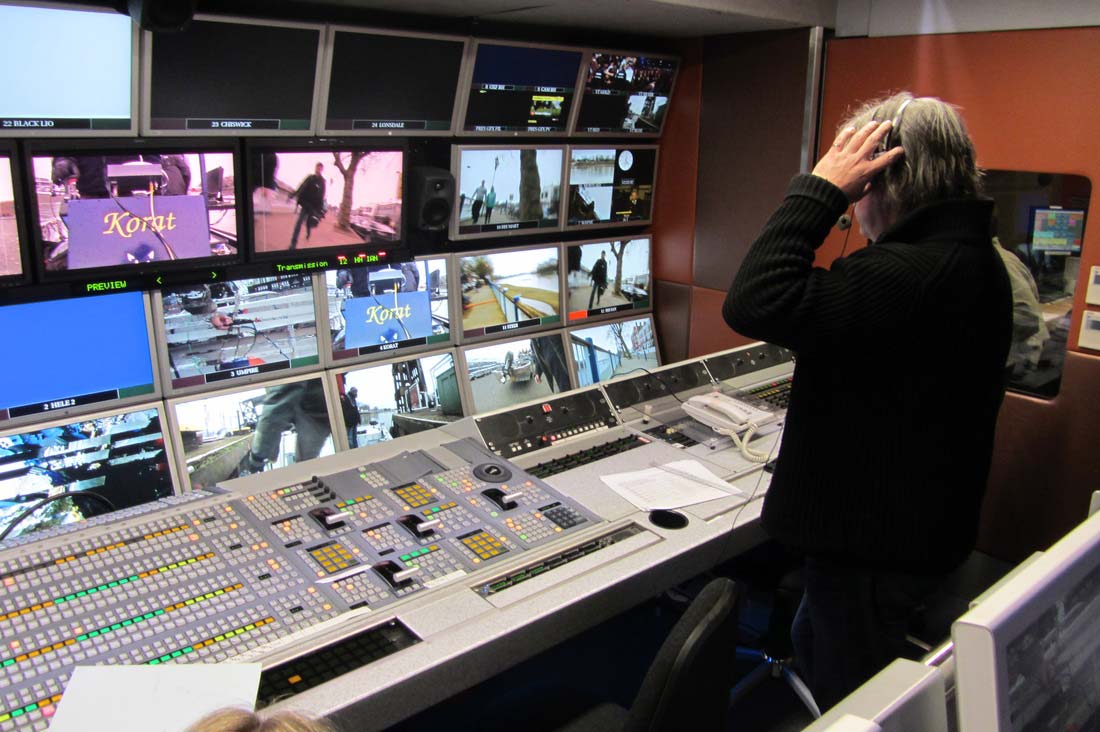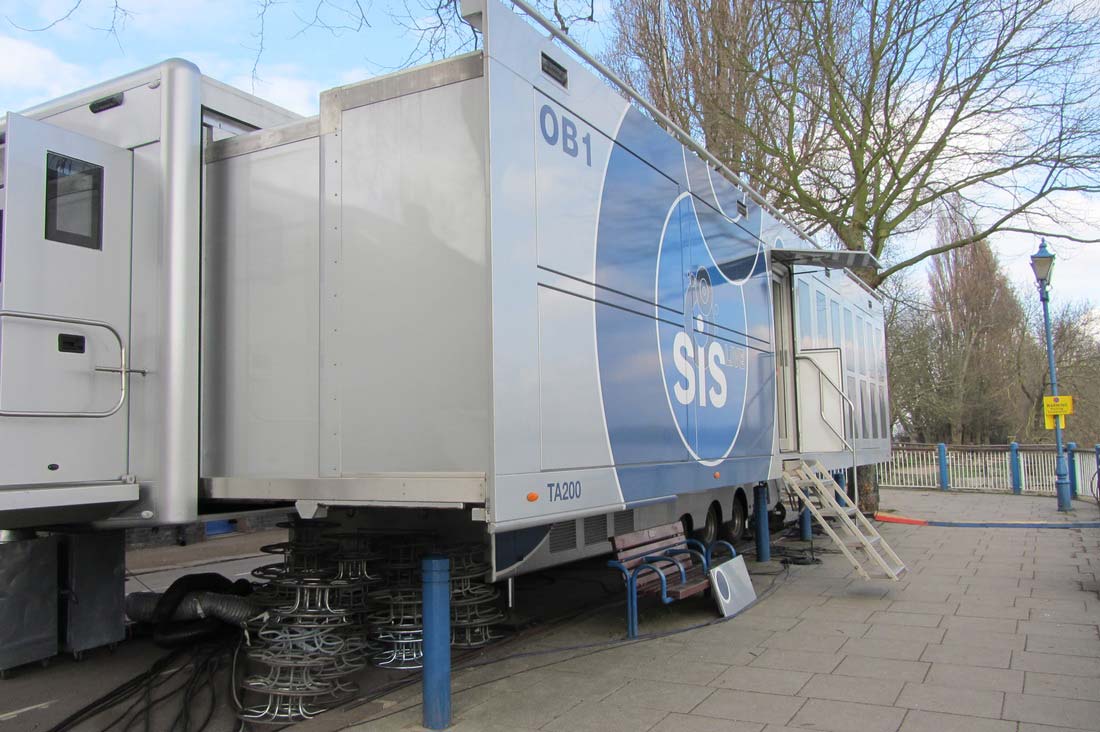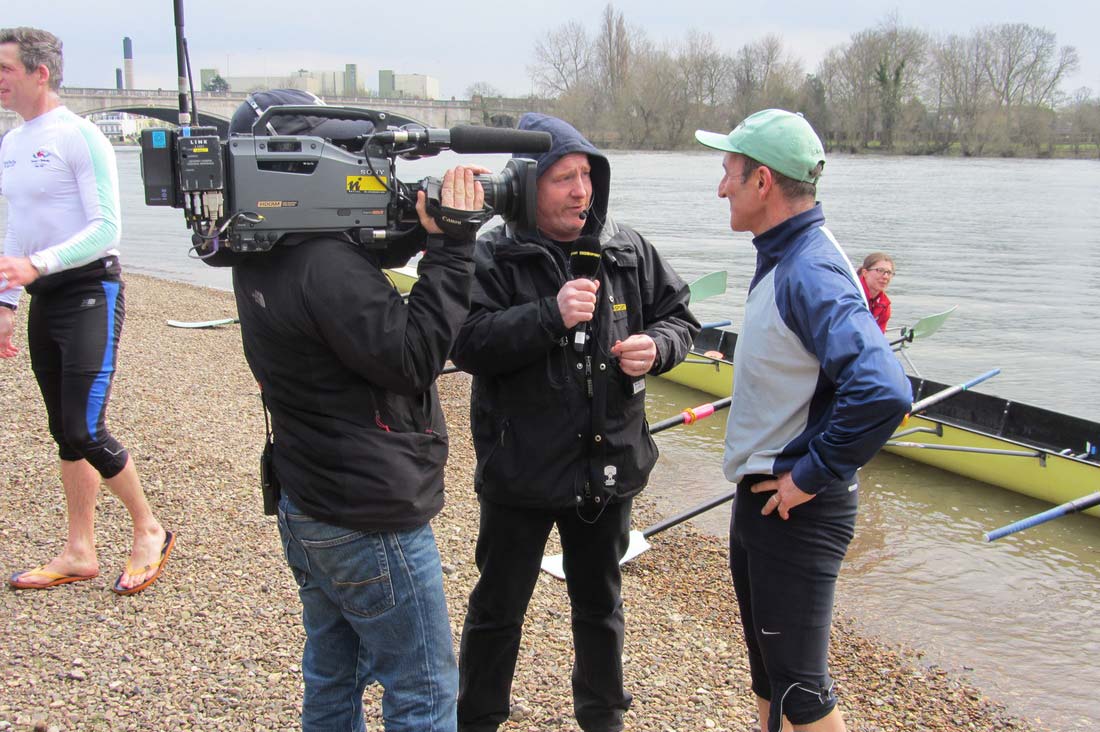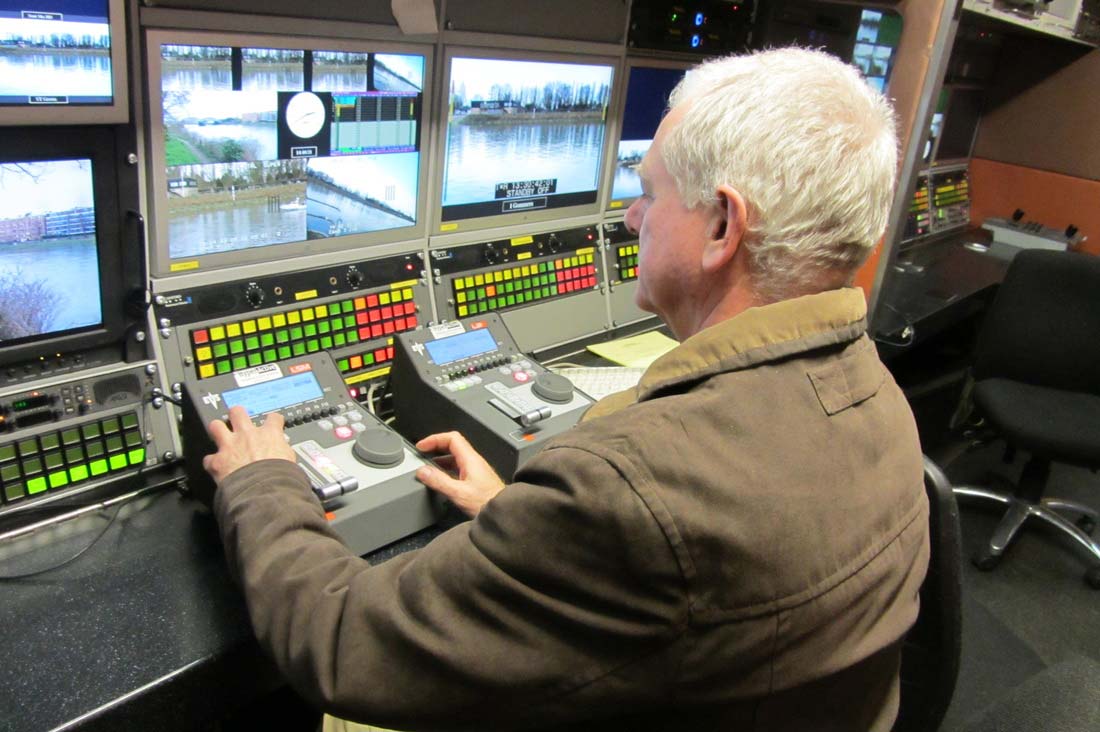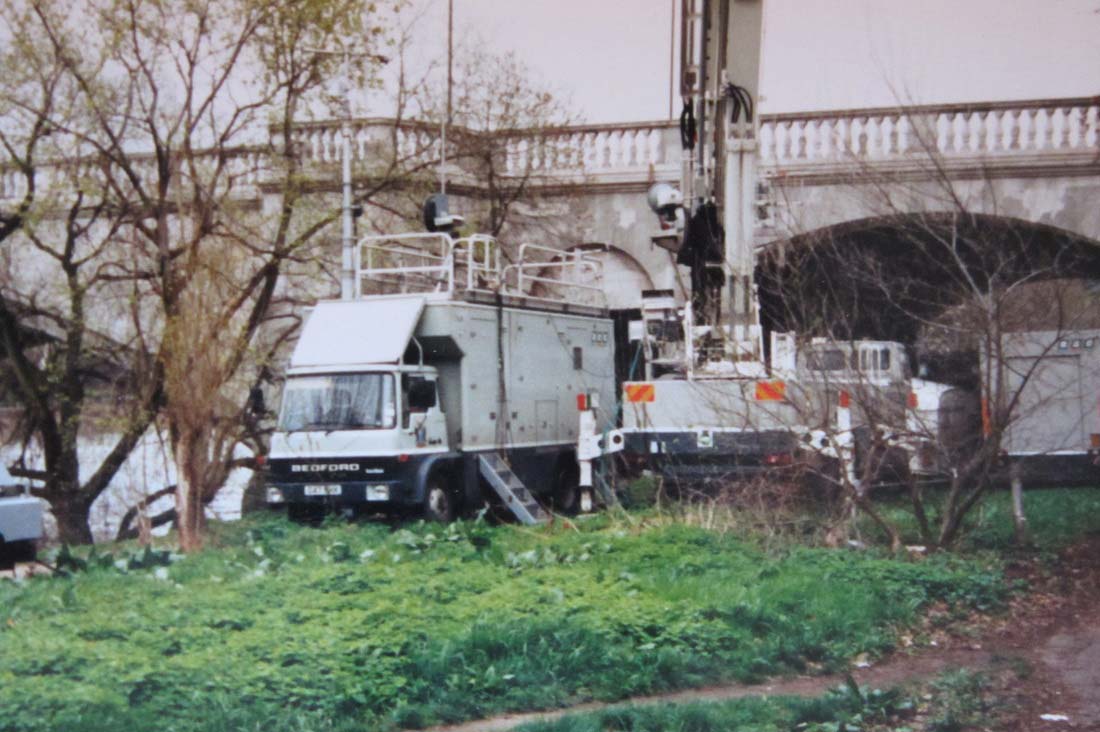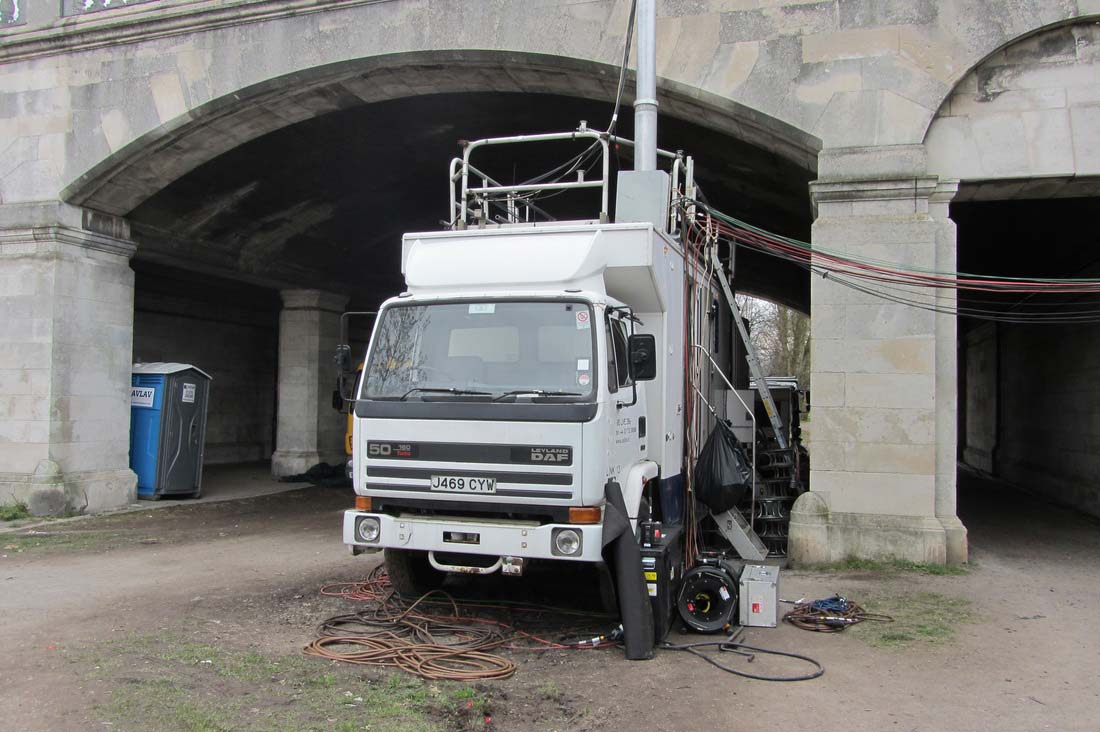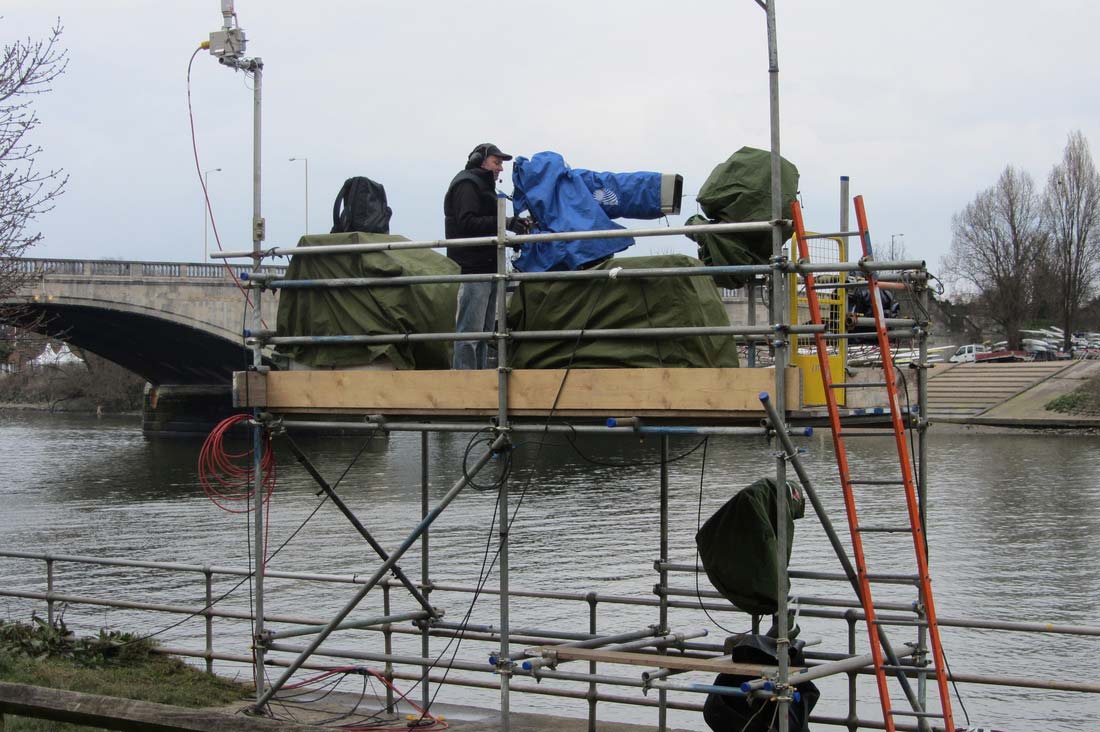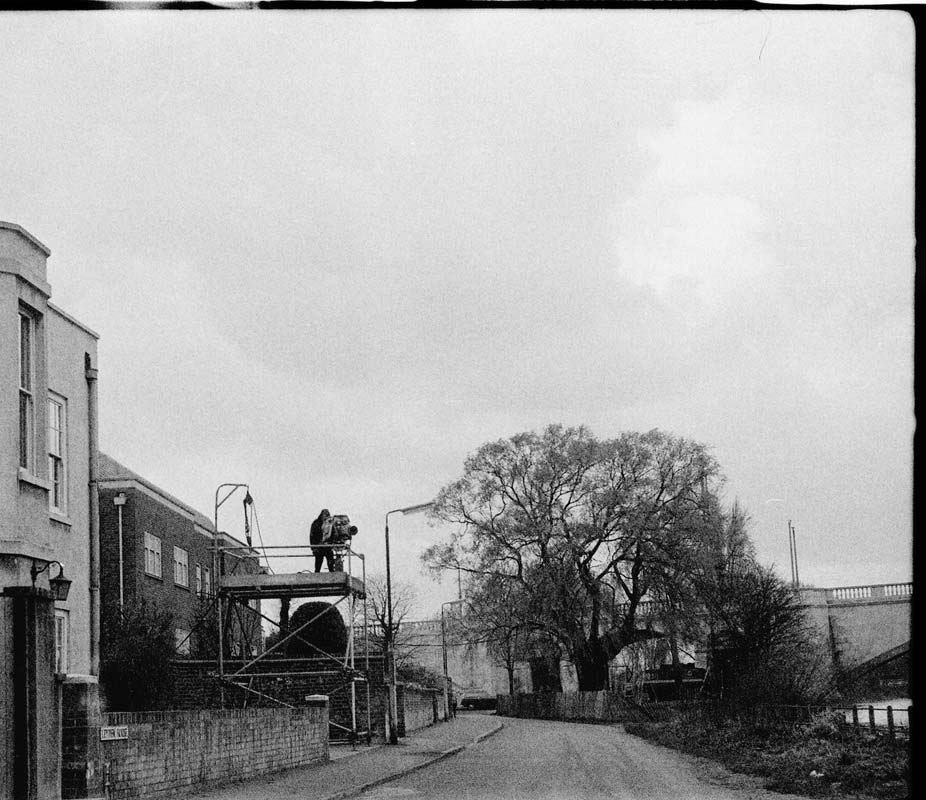In April 2013 the 159th University Boat Race took place. The course stretches along four and a quarter miles of the River Thames from Putney to Mortlake. This is the same course as it was in 1938 when the fledgling BBC Television Service boldly decided to televise the event. Seventy-five years ago the BBC had just one outside broadcast unit, MCR 1, which had just three cameras that covered the finish at Mortlake. The start and middle of the race were covered in sound only, using the radio commentary of John Snagge, and illustrated in the Alexandra Palace studio using a chart of the racecourse with the two boats being moved along it using magnets. It wasn’t until 1949 that the BBC was able to televise the whole race using eight shore-based cameras and one camera in a launch that followed the race boats.
This 1949 broadcast was seen as a great success prompting D.C. Birkinshaw, Superintendent Engineer, Television Outside Broadcasts, to send a memo to the production team. ‘ I would appreciate a jotting giving your impressions of the Boat Race this year and what improvements you would like to see next year. I am conscious that the phraseology leaves the matter wide open for you to request six gyro-dynes and fifty-five shore based cameras.’ In 2013 John Roberts, the present day Engineering Manager for SIS Live who now provide the facilities, comments. “We haven’t quite got up to fifty-five land-based cameras yet, but I think that is only on grounds of cost, we have to make do with thirty four, including the ones bobbing about on the water. Only four of those are gyro-dynes, as Mr Birkinshaw puts it.”
In 1949 the difficulty of covering a four and a quarter mile course involved the vision feeds being switched in seven different locations culminating at Broadcasting House, where pictures were switched between Putney and the rest of the course. Ideally today it would be good to bring all the camera feeds back to one control room but as John Roberts said, although it would be possible, the cost would make it prohibitive. So for televising the 2013 Boat Race the BBC used two mobile control rooms for the domestic programme. SIS Live’s OB1 was stationed at Putney and covers the preparations, interviews and the race as far as Barnes Bridge. From there on, the race then the interviews and presentations were covered by OB7, located near the boathouses just beyond Chiswick Bridge. SIS Live’s OB 14 was also at Putney to facilitate the international commitment. OB14 mainly takes the pictures from OB1 creating a slightly different mix and a separate commentary.
OB1 is the largest mobile control in the UK. It can handle up to twenty-four cameras. In the main production area, Paul Davies the executive producer of the Boat race programme, who is directing the output from OB1, is confronted with twenty-one monitors. Fourteen monitors show the pictures from the land-based cameras at Putney and as far along the river as Barnes Bridge; two monitors show the feeds from both helicopters and five more the pictures from the waterborne cameras. There are also monitors showing the outputs from the nine channel EVS replay machine, VT and two graphic stations. The three central monitors show the mixer output from OB7 alongside the preview and TX output.
Since the BBC started televising the Boat Race, it has been one of the most popular sporting events on TV. In the 1960s it could command an audience of around 10,000,000 people. In those days the race was just another but popular item in the Saturday afternoon Grandstand programme. Now the Boat Race programme commands a two-hour slot with a big build up to the race hosted by Claire Balding. She opens the programme outside the boathouses at Putney where there are two Jimmy Jibs, two hand-held radio cameras and a Steadicam radio camera. All the microphones used for her interviews have delay put in the line to match the radio camera output. The Jib operated by GTC member Julian Harries covers the wides on the interviews, shots of the boats as they prepare for the race plus a sweeping shot as the crews race past the boathouses. Richard Stevenson’s Jib operated by Steve Fuller follows each Oxford crewmember as they are introduced carrying their oar down to from the boathouse to the water’s edge. The Steadicam does the equivalent for the Cambridge crew.
The waterborne cameras are a very important part of the broadcast. When the BBC first managed to have a camera on the river in 1949, it was a standard Marconi Mk 1 mounted on a tripod in the bow of a launch that followed the umpire’s launch. Today two cameras are actually in the umpires boat directly behind the race boats. One is a hand-held camera that can give shots of the umpire and the second is a remote head camera in a gyro-stabilised mount supplied by ACS. Another gyro-stabilised remote camera is mounted on the ‘Chase Boat’ that travels along the ‘Middlesex’ bank parallel to the racing boats. This boat also controls the output from the racing boat. Each racing boat has two miniature cameras. One is mounted on a stalk looking over the Cox’s shoulder and can be panned remotely to show the opposing boat. The second camera is at the Cox’s feet looking up at him. There is only one vision feed from each boat so the choice of which camera signal is sent, is controlled remotely. All the pictures from the waterborne cameras are picked up by an array of semi directional antennae at five locations along the course and sent back to OB1 at Putney by a combination of fibre and satellite. The receivers at Mortlake also feed OB7 so that Sean Hughes can intercut shots from the boats after the race has finished.
Flying TV based at Denham Airfield this year provided two R44 Helicopters kitted out with a Cineflex Ikegami 5-axis stabilised system with an Ikegami F30 3CCD sensor camera and Canon 44X lenses. Both helicopters fly backwards for most of the race and, apart from the police helicopters, are given exclusive use of the airspace. One helicopter flies just in front the two boats giving an accurate indication of which boat is ahead. The second helicopter at the rear can give a good geographical picture of where the boats are on the course. The signal from the omni-directional antennae on each helicopter is picked up by an array of six receiver antennae on a hoist at Putney. John Roberts says that “We don’t need to pick up the signal from a great distance, We don’t use the old analogue microwave dish that has to be aimed at the helicopter but, using the array with semi directional heads we can see the picture when the helicopters take off from their base at Denham in Bucks, but we lose them for a while as they fly the long way round because of Heathrow so pop out from behind us .“
Since 1948 it had been the ambition of the Boat Race production team to get aerial shots of the race from a helicopter. In 1948 the BBC allocated a thousand pounds for a trial using a helicopter, but for whatever reason the trial never took place. In 1955 there was an offer from a company to provide a Bell 47G helicopter with floats. The company wrote to Peter Dimmock ‘…If you are interested in having our helicopter cover the Boat Race, this could be done in three ways; by taking the entire equipment in the aircraft (though it is unlikely that this will be possible); by using a cable linked to a launch and flying under the bridges; by using a cable but disconnecting and reconnecting on the other side…’ Peter Dimmock, Head of Outside Broadcasts at that time, wrote back referring ‘your interesting letter’ to the BBC’s engineering department ‘. …to discuss the pros and cons of trailing a camera cable between the helicopter and our Boat Race launch.’ He went on to write ‘On the other hand, we are most interested in the possibilities, should the technical side seem feasible, then I will at once discuss the matter with the Boat Race Committee and other organisations concerned…’
Unsurprisingly there were no aerial shots of the race that year. It was not until 1968 that this was achieved with a little help from the French and the Italians. An Allouette 3 helicopter was hired at great expense from a company in Paris and RAI, the Italian state broadcaster, provided the links equipment that sent not only the picture from the monochrome camera provided by the BBC in the helicopter, but also relayed the pictures from the two cameras on the BBC launch, back to the central control at Putney. Now in 2013 for the first time there are two helicopters covering the Race.
Perhaps the most complicated part of televising the Boat Race has been the Comms, with cameras spread along the four-mile course as well as on boats and helicopters. In 1939 it was the first time two outside broadcast units had been used at the same time. MCR 1 was at Putney while MCR 2 was at the finish. The BBC did have two transmitter vans but, because both transmitters used the same frequency, the signal from Putney went first down an ordinary telephone line and then from central London via the special coaxial cable laid in 1937 to Alexandra Palace. In 1949 there were three cameras at Putney; two at Harrods Depository; one at Chiswick Wharf; two at Mortlake and one in the launch ‘Consuta’. Getting a waterborne camera was quite an achievement. A standard Marconi Mk 1 camera was on a tripod in the bow. A generator powered the CCU and Pye transmitter.
Ron Chown who joined the BBC just after the Second World War remembered his time working on the Boat Race.
“My first Boat Race was in the spring of 1949 and by then I was attached to Radio Links. It was the first time that a camera had been put on a boat with a radio link connection to shore, and as London was the only TV station in the UK, we used the future frequency of Birmingham for the link. My job at the receiver end was to adjust the contrast knob on the receiver to give a steady output via an oscilloscope to the nearby MCR. In order to make sure that the central producer, Peter Dimmock, could talk to us all, the Sound transmitter from Alexandra Palace was used. Anybody at home who had left his or her set on could have received talkback. There was no other way of contacting everyone. For boat to shore communication we had a “Voice Operated Lamp”, which was OK if the pathway was clear and it wasn’t raining. For the next few years I managed to get on to the Boat for my “Spring Cruise”, as it took us about four days rigging and testing. Considering the things we tried to do with the equipment that was available, we did very well. The Boat Race was always hard work, rigging onto the boat and keeping the two generators full of fuel. The first year we had a small boat, the ‘Consuta’, but when we got two cameras we had a small cabin cruiser, the ‘Everest’. I’ve had many happy hours up and down the Thames from Putney Bridge to Mortlake and I knew every landmark along the way. I always referred to my week on the Boat Race as my ‘Spring Cruise’.”
In the early days the use of telephone lines for vision circuits to connect the various sites along the route was essential. In 1956 John Vernon, the veteran producer of the Boat Race programme, wrote to four members of the public who owned houses along the course. ‘ Dear Sir In past years you have very kindly allowed us to use your telephone line in connection with our Boat Race Broadcasts. This year, the Post Office have been able to fulfil our requirements using service circuits and so we shall not on this occasion be asking for your co-operation.’
By the 1960s the use of telephone lines was being replaced by microwave links. A mass of dishes were erected on a number of Eagle Towers (The BBC extending mast vehicle), tall buildings and specially erected scaffolding platforms. John Roberts, the present day EM, used pictures of the 1960’s microwave complex to show Wandsworth Council how relatively unobtrusive today’s comms are. Where once there was a huge scaffolding tower at Putney with a mass of microwave dishes, now there is just one hoist carrying all the antennae and the five receiving antennae heads on the riverbank along the course look more like a small speaker array.
In 2013 the cameras along the course are connected back to the control rooms in many different ways. Apart from the five cameras used for the interviews and crew introductions at Putney, there are another seven land-based cameras connected to vision control in OB1. one at Putney Bridge (radio link), the next on a second hoist next to OB1 (fibre) and a third at the one-mile post (fibre). Four other cameras beyond Hammersmith Bridge are connected through a SIS Live links unit next to the old BBC Riverside studios. A hoist raises the two microwave dishes above the studios and Riverside Exchange and point towards Putney where they are received by a matching pair of dishes on the hoist by OB1. There are two further land based cameras feeding into OB1. One at Chiswick Steps and the next at Lonsdale Road, the Putney side of Barnes Bridge. Both these cameras send their pictures back to OB1 via separate sat trucks and the vision outputs are controlled locally.
As soon as the boats travel under Barnes Bridge, OB7 takes over the coverage using twelve land-based cameras. OB 7 acts as a ‘satellite’ unit to OB1. The OB1 director, who is responsible for the final output, can take the feed from OB7’s mixer output or select pictures from the two helicopters, or the five waterborne cameras as well as playing in the animated course from one of the graphic stations. With the output of OB7 not necessarily going to air it can be quite confusing for the cameramen. To help the camera operators there are two return feeds on each camera. One showing the output from OB7 and the other shows the off-air BBC1 signal. As Sam Curtis, camera supervisor for OB7 said,
“ You don’t want to be crashing out when you are on air, but Sean is very good at keeping us informed.” After the finish line and Chiswick Bridge the pictures from the race boats are switched into OB7 allowing senior producer, Sean Hughes, who is directing the OB7 operation, to intercut the shots from the winning and losing boats with the shots from Chiswick bridge and the Chiswick boathouse cameras where the presentation takes place.
Nearly a mile of fibre cable connects the camera at Barnes Bridge with OB7 at the Chiswick boathouses. There is another camera between Barnes and Chiswick Bridge and then a Jimmy Jib outside the Ship Inn some 100yards before the finish, which rises above the crowds cheering to reveal the boats sprinting towards the finish. On the finish line, where once there would have been one camera, there are now three. The first gives a wide as the boats cross the finishing line. The second is a slomo camera used for close ups of the winning team directly after the finish, which can be played back immediately from the EVS unit in OB7. The third is a fixed camera right on the finishing line. In the OB truck Dave Chapman, the engineering manager for OB7, is sets up a white line over the river on the vision mixer to represent the finish line. In the event of a close finish, the recording of the finish can be replayed from the truck down to a monitor on the opposite side of the Thames where the finish judge is positioned. The only dead heat was declared in 1877, but of course the judge then did not have the advantage of an EVS replay provided by SIS Live. The next camera is midway across Chiswick Bridge. A Sony 2500 fitted with 86 to1 zoom lens which can look right up the course and see the boats coming round the bend from Barnes Bridge. This camera (six) is abandoned once the boats have passed under the bridge, as GTC member Simon Curtis crosses the roadway to operate camera seven that looks towards the boathouse and presentation area. OB7 has a four channel EVS machine, so three feeds from other cameras, which cover the finish, can be fed into the replay machine. The Jib camera is also recorded onto a Digi-beta tape which, after the finish, is fed with Sam Curtis’s radio camera which is covering interviews and the presentation. There are another three cameras on the shore that cover the winning and losing crews arriving at the boathouse, the interviews and the presentations. One is fixed on the first floor balcony, the other three including Sam’s are kept busy with half an hours hectic activity. But as Sam says covering the Boat Race is not like televising a football match. Some cameramen are in position for two days just to capture the passing racing boats for a few seconds.
Rob McDonald is more used to studio work, having spent many years at TVC, but for this year’s Boat Race he is operating the camera at Lonsdale Road, near Barnes Bridge. This year the boats sped past this remote location without incident. In the Boat Race the unexpected can happen. In 2012 an incident happened between Hammersmith and Barnes Bridges, where a man swam in front of the racing boats and the race had to be halted by the umpire. There was a delay of some thirty minutes before the race was re-started, so having a land based camera at that point, helped to cover the ensuing confusion. Sean Hughes, who was directing that part of the race last year, said it was also fortunate that the assistant umpire, Matthew Pinsent, on the launch was miked up so, on air, he could keep everybody updated as to what was happening. All the cameras were being recorded on the 12 channel EVS in OB1 but unfortunately, at a critical moment, the white flag of the umpire had dropped over the umpire’s launch camera, partly obscuring the view when the boats went past the swimmer. Secondly the power supply for the cameras on both racing boats had failed and because the race took so long to re-start, the helicopter had to leave as it was running low on fuel. It is important to make sure that if things go wrong, which can happen on any OB, enough resources are in place that the viewer is unaware. In the early days of outside broadcasts things often did go wrong and the broadcast was lost or there was a break in transmission. Peter Dimmock, Head of BBC Television Outside Broadcasts from 1954 to 1976, thought the viewers accepted this happening “If we had a breakdown, viewers didn’t mind. It was all part of the fun. Doing something new.” Today, I think the viewers would have a very different perspective.
This 1949 broadcast was seen as a great success prompting D.C. Birkinshaw, Superintendent Engineer, Television Outside Broadcasts, to send a memo to the production team. ‘ I would appreciate a jotting giving your impressions of the Boat Race this year and what improvements you would like to see next year. I am conscious that the phraseology leaves the matter wide open for you to request six gyro-dynes and fifty-five shore based cameras.’ In 2013 John Roberts, the present day Engineering Manager for SIS Live who now provide the facilities, comments. “We haven’t quite got up to fifty-five land-based cameras yet, but I think that is only on grounds of cost, we have to make do with thirty four, including the ones bobbing about on the water. Only four of those are gyro-dynes, as Mr Birkinshaw puts it.”
In 1949 the difficulty of covering a four and a quarter mile course involved the vision feeds being switched in seven different locations culminating at Broadcasting House, where pictures were switched between Putney and the rest of the course. Ideally today it would be good to bring all the camera feeds back to one control room but as John Roberts said, although it would be possible, the cost would make it prohibitive. So for televising the 2013 Boat Race the BBC used two mobile control rooms for the domestic programme. SIS Live’s OB1 was stationed at Putney and covers the preparations, interviews and the race as far as Barnes Bridge. From there on, the race then the interviews and presentations were covered by OB7, located near the boathouses just beyond Chiswick Bridge. SIS Live’s OB 14 was also at Putney to facilitate the international commitment. OB14 mainly takes the pictures from OB1 creating a slightly different mix and a separate commentary.
OB1 is the largest mobile control in the UK. It can handle up to twenty-four cameras. In the main production area, Paul Davies the executive producer of the Boat race programme, who is directing the output from OB1, is confronted with twenty-one monitors. Fourteen monitors show the pictures from the land-based cameras at Putney and as far along the river as Barnes Bridge; two monitors show the feeds from both helicopters and five more the pictures from the waterborne cameras. There are also monitors showing the outputs from the nine channel EVS replay machine, VT and two graphic stations. The three central monitors show the mixer output from OB7 alongside the preview and TX output.
